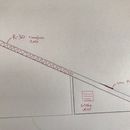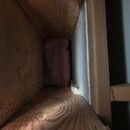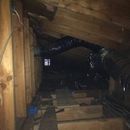Unvented cathedral ceiling with “devil’s triangle”
hey everyone Id like to get your opinion. Ill try to be brief 🙂
I have an unvented cathedral ceiling above an Open living room and a loft area with 2×10 rafters that are stuffed with R30 fiberglass faced batts. There is no ridge vent on top of the roof (or soffit vents), but the attic space behind the knee wall is vented (gable vent) and air can go up between the rafters… but not escape.
I thought about taking down all the sheetrock and spraying 1″ cC spray then putting Rockwool between the rafters and sealing off the cathedral ceiling from the vented attic space behind the knee wall.
Should I just continue the same approach all the way down the roofline. making the attic space behind the knee wall conditioned?
OR
run my insulation down the back of the knee wall and on the attic floor leaving the small section of the attic space vented?
which method would keep the room on the other side cooler?
zone 3b
shingle roof
no open flame heating in attic space , only ducts
Thank you.
GBA Detail Library
A collection of one thousand construction details organized by climate and house part












Replies
iv read that while doing a flash a bat insulation in a cathedral ceiling its good to have sheetrock on the ceiling with latex paint
Does the same apply to the attic space if I create a conditioned attic with flash and bat system between the rafters? would I have to put sheetrock inside the attic space too?
or could I just leave the Rockwool batts exposed to the attic space?
possibly add an extra layer of rigid foam to cut down on thermal bridging of the rafters.?
or would that create a trapped environment for the insulation between the rigid foam and the CC spray foam?
Akos,
Of the two approaches you are considering -- leaving the attic behind the kneewall outside of the thermal envelope, or bringing the attic inside the thermal envelope by insulating the sloping roofline -- the preferred method is the latter.
For more information on this issue, see “Two Ways to Insulate Attic Kneewalls.”